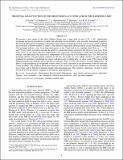| dc.contributor.author | Da Rio, N. | |
| dc.contributor.author | Robberto, M. | |
| dc.contributor.author | Hillenbrand, L. A. | |
| dc.contributor.author | Henning, T. | |
| dc.contributor.author | Stassun, Keivan | |
| dc.date.accessioned | 2015-02-18T20:48:57Z | |
| dc.date.available | 2015-02-18T20:48:57Z | |
| dc.date.issued | 2012-03 | |
| dc.date.submitted | 2011-09 | |
| dc.identifier.issn | 0004-637X | |
| dc.identifier.issn | 1538-4357 | |
| dc.identifier.uri | http://hdl.handle.net/1721.1/94617 | |
| dc.description.abstract | We present a new census of the Orion Nebula Cluster over a large field of view (gsim 30' × 30'), significantly increasing the known population of stellar and substellar cluster members with precisely determined properties. We develop and exploit a technique to determine stellar effective temperatures from optical colors, nearly doubling the previously available number of objects with effective temperature determinations in this benchmark cluster. Our technique utilizes colors from deep photometry in the I band and in two medium-band filters at λ ~ 753 and 770 nm, which accurately measure the depth of a molecular feature present in the spectra of cool stars. From these colors we can derive effective temperatures with a precision corresponding to better than one-half spectral subtype, and importantly this precision is independent of the extinction to the individual stars. Also, because this technique utilizes only photometry redward of 750 nm, the results are only mildly sensitive to optical veiling produced by accretion. Completing our census with previously available data, we place some 1750 sources in the Hertzsprung-Russell diagram and assign masses and ages down to 0.02 solar masses. At faint luminosities, we detect a large population of background sources which is easily separated in our photometry from the bona fide cluster members. The resulting initial mass function of the cluster has good completeness well into the substellar mass range, and we find that it declines steeply with decreasing mass. This suggests a deficiency of newly formed brown dwarfs in the cluster compared to the Galactic disk population. | en_US |
| dc.description.sponsorship | Deutsche Forschungsgemeinschaft (Sonderforschungsbereich SFB 881 “The Milky Way System” (subproject B6)) | en_US |
| dc.language.iso | en_US | |
| dc.publisher | Institute of Physics/American Astronomical Society | en_US |
| dc.relation.isversionof | http://dx.doi.org/10.1088/0004-637x/748/1/14 | en_US |
| dc.rights | Article is made available in accordance with the publisher's policy and may be subject to US copyright law. Please refer to the publisher's site for terms of use. | en_US |
| dc.source | American Astronomical Society | en_US |
| dc.title | THE INITIAL MASS FUNCTION OF THE ORION NEBULA CLUSTER ACROSS THE H-BURNING LIMIT | en_US |
| dc.type | Article | en_US |
| dc.identifier.citation | Da Rio, N., M. Robberto, L. A. Hillenbrand, T. Henning, and K. G. Stassun. “THE INITIAL MASS FUNCTION OF THE ORION NEBULA CLUSTER ACROSS THE H-BURNING LIMIT.” The Astrophysical Journal 748, no. 1 (February 29, 2012): 14. 2012. © 2012 The American Astronomical Society. | en_US |
| dc.contributor.department | Massachusetts Institute of Technology. Department of Physics | en_US |
| dc.contributor.mitauthor | Stassun, Keivan | en_US |
| dc.relation.journal | Astrophysical Journal | en_US |
| dc.eprint.version | Final published version | en_US |
| dc.type.uri | http://purl.org/eprint/type/JournalArticle | en_US |
| eprint.status | http://purl.org/eprint/status/PeerReviewed | en_US |
| dspace.orderedauthors | Da Rio, N.; Robberto, M.; Hillenbrand, L. A.; Henning, T.; Stassun, K. G. | en_US |
| mit.license | PUBLISHER_POLICY | en_US |
| mit.metadata.status | Complete | |
